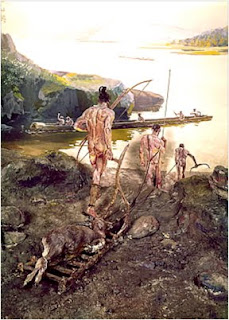It is interesting that such a question would even be asked. We know nothing of the living conditions in the land of First Inheritance. What we do know is:
1. They pitched their tents upon landing (1 Nephi 18:23),
2. They tilled the ground and planted their seeds. These Jerusalem seeds grew exceedingly and provided them with an abundance (1 Nephi 18:24).
3. They found, within walking distance of where they landed, beasts in the forests of every kind, both the cow and the ox, and the ass and the horse, and the goat and the wild goat, and all manner of wild animals, which were for the use of man (1 Nephi 18:25).
4 They found all manner of ore, both of gold, and of silver, and of copper (1 Nephi 18:25). And Nephi made plates from this ore on which to write (1 Nephi 1 Nephi 19:1-4).
5. Nephi, and those who would go with him, were warned to flee into the wilderness (2 Nephi 5:5). They took their tents and possessions, and the records and the Liahona (2 Nephi 5:12), and “did journey in the wilderness for the space of many days. And after we had journeyed for the space of many days we did pitch our tents. And my people would that we should call the name of the place Nephi; wherefore, we did call it Nephi” (2 Nephi 5:7-8).
Obviously, there is nothing in these passages and the scriptures to suggest anything “about living conditions in the land of first inheritance,” other than they lived in tents. Later, Jacob describes the Lamanites in the Land of First Inheritance as better than the Nephites: “Behold, the Lamanites your brethren, whom ye hate because of their filthiness and the cursing which hath come upon their skins, are more righteous than you; for they have not forgotten the commandment of the Lord, which was given unto our father” (Jacob 3:5).
 Evidently, the Nephites at this time had some intercourse with the Lamanites for “many means were devised to reclaim and restore the Lamanites to the knowledge of the truth; but it all was vain” (Jacob 7:24). Wars (or battles) took place between the two groups and continued into Enos’ time (Enos 1:24), who described the Lamanites as “wild, and ferocious, and a bloodthirsty people, full of idolatry and filthiness; feeding upon beasts of prey; dwelling in tents, and wandering about in the wilderness with a short skin girdle about their loins and their heads shaven” (Enos 1:20).
Evidently, the Nephites at this time had some intercourse with the Lamanites for “many means were devised to reclaim and restore the Lamanites to the knowledge of the truth; but it all was vain” (Jacob 7:24). Wars (or battles) took place between the two groups and continued into Enos’ time (Enos 1:24), who described the Lamanites as “wild, and ferocious, and a bloodthirsty people, full of idolatry and filthiness; feeding upon beasts of prey; dwelling in tents, and wandering about in the wilderness with a short skin girdle about their loins and their heads shaven” (Enos 1:20).By the time of Jarom, Lehi’s great grandson, the Nephites “were scattered upon much of the face of the land, and the Lamanites also. And they were exceedingly more numerous than were they of the Nephites; and they loved murder and would drink the blood of beasts” (Jarom 1:6). But evidently, the Nephites knew little, if anything, of the land of First Inheritance, for the Lamanites “came many times against us, the Nephites, to battle” (Jarom 1:7), suggesting these battles and wars took place in the land of Nephi, not where they originally landed, or the place of the Lamanite “first inheritance.” By this time, the Nephites called the city of Nephi and surrounding land their “inheritance” (Jarom 1:7).
Around 250 B.C., Lehi’s 5th great grandson, Amaleki, speaks of his contemporary, Mosiah, fleeing the Land of Nephi and discovering Zarahemla (Omni 1:12-13).
In all of this, the first 350 years in the Land of Promise, not one word is mentioned to describe the “living conditions in the land of first inheritance”—where the Lehi Colony first landed. Yet, despite this, Sorenson precedes to tell us all about this land and its environment, and it effect upon the Lamanites.
(See the next post, “Was Guatemala the Land of Nephi? Part II,” for how Sorenson fancifully describes this area.”




No comments:
Post a Comment